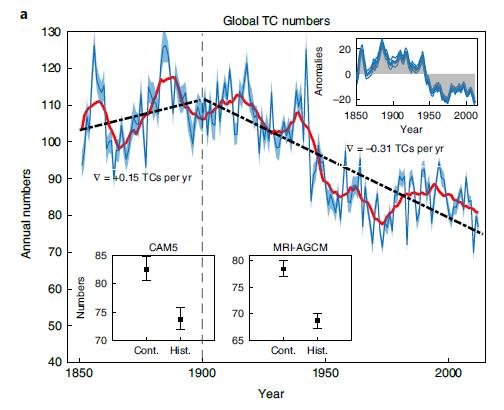As the Atlantic hurricane season finally begins to pick up, AccuWeather forecasters are predicting that Hurricane Ian may become a Category 4 hurricane in the Gulf of Mexico in the coming days. However, there is the possibility that high wind shear will hamper the storm’s ability to remain organized and/or remain that powerful as it approaches land. This is consistent with the data showing hurricanes may decrease in frequency and intensity amid modest warming.
The article, “Hurricane Ian forecast to explosively strengthen into Cat 4 storm in Gulf,” gives a detailed analysis of current conditions in the Gulf which are in some ways favorable, and in some ways not-so-favorable, for storm intensification over the coming days.
If the storm fails to make landfall as a Cat 4, it may be due to the effect of wind shear. AccuWeather reports that over the last week, the storm now named Ian has struggled to stay organized due to “persistent wind shear,” limiting its ability to gain strength.
Meteorologist Andrew Johnson-Levine writes:
As an additional factor, more wind shear will likely be in place across the northern half of the Gulf of Mexico, which could act to decrease the hurricane’s wind intensity as it nears land. Whether Ian reaches this wind shear or not before making landfall could make the difference between a major hurricane striking a densely populated area, or a system with less wind intensity.
If the jet stream is able to dip southward early, Ian could be steered into the west coast of Florida before interacting with high wind shear, causing the hurricane to be much stronger at landfall. On the other hand, a slower jet stream arrival could allow Ian to drift toward the northern Gulf Coast, where high wind shear would drop the wind intensity prior to landfall,” Douty explained, noting that very tiny track differences could make the difference between the two scenarios.
Climate Realism has followed hurricane activity closely this season, detailing the slow start here, here, and here, for instance. This past August was the first since 1997 to pass without any named tropical storms or hurricanes, and such a quiet start to hurricane season has only occurred 18 times since 1851. High wind shear was one factor credited with the slow start to the 2022 hurricane season.
Wind shear inhibits strong storms from forming and rips apart storms that have already formed. Science indicates global warming is likely to cause more wind shear in places where hurricanes form and intensify, leading to fewer hurricanes overall. Historic hurricane data in combination with models such as those used in the study, “Declining tropical cyclone frequency under global warming,” agree that there has been a decline over several decades in tropical cyclone frequency. The authors of the above study say they found “robust declining trends in the annual number of TCs at global and regional scales during the twentieth century” and that the trends are “consistent with the twentieth century weakening of the Hadley and Walker circulations, which make conditions for TC formation less favourable.” (See figure below)

Current forecasts strongly indicate Hurricane Ian will strengthen into a Category 4 in the coming days. We can all pray the wind shear effect described by AccuWeather meteorologists and in recent studies discussing hurricanes will end up coming into play, causing the storm to become disorganized or at least reducing its intensity before it makes landfall. The only thing we can say for sure is that hurricanes of various strengths will continue to form each hurricane season, regardless of climate change.

















